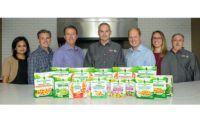The frozen food category is uniquely challenging for both brands and retailers. As consumers become more demanding in their food choices, frozen food processors must stay ahead of the dynamic shifts—those that are currently driving category changes, as well as those expected to make waves in the months to come. Among those challenges? The fight for shelf space between large national consumer packaged goods (CPG) leaders and the more modern challenger food brands.
However, the recent “frozen frenzy” will inevitably wane and crest. Notably, a study presented by Information Resources, Inc., Chicago, and Boston Consulting Group, Boston, documented that 46% of the growth of the food/beverage sector is coming from small companies. Indeed, these are the brands that bring authenticity and inspiration to the frozen food aisle.
It is ever more important that challenger brands keep fighting the good fight to win the hearts and stomachs of modern consumers. As new brands bring values to consumers for a value, these same efforts can be bolstered by retail partners dedicated to ensuring the culinary excellence, authenticity, transparency and sustainability of the frozen food aisle.
Between 2009 and 2011, the frozen food aisle was regarded as a sort of “Death Valley.” Major brands were spiraling downward, however, “modern” lifestyle food brands, such as Saffron Road Foods, a wholly owned subsidiary of American Halal Co., Inc., Stamford, Conn., paved the way through innovation and pioneered higher standards as the best practices for today’s frozen brands. Here are some strategies brands may look to while navigating current challenges:
Keep a tight focus on innovation and future trends – not the rear-view mirror. Frozen food processors must deliberately look ahead and tune into the future of smart shoppers, preparing for Millennials who are coming of age, making different purchasing decisions based on their changing lifestyles and entering the work force with a different set of needs than previous consumers.
This practice of forward thinking was championed during 2011’s challenges by Saffron Road and Whole Foods, Austin, Texas, both on a mission to rid the freezer aisle of antibiotics and promote healthier food choices. Moreover, higher sourcing standards meeting gluten-free certified, halal or antibiotic-free claims will continue to draw Millennial consumers who may not typically come to the frozen shelf.
Tune into culinary expertise – the “wow” factor. After challenger frozen food brands carved out their own space in the freezer case, national brands began re-entering the market to follow suit. And through acquisitions of challenger brands or brilliant “refreshing” of legacy brands, traditional brands also drove strong performance in the last two years. Now, challenger brands are faced with new competitors with formidable resources.
In the frozen category, one’s marketing and social media reach needs to communicate the brand’s culinary excellence. Millennials are driving over 40% of the growth of the frozen market, according to another report published by IRI, meaning their taste for complex flavors and authentic culinary adventures will drive a brand’s success, especially in natural/organic channels, which are driving 50% of the frozen growth.
When the dust clears, shopper trial will continue, but will shift back to the authentic modern lifestyle brands that deliver on the promise put on the package.
Back to the future: Traditional methods win
Right now, there is a lot of sizzle and excitement around the frozen category. While plant-based entrants are rapidly gaining traction, they only represent $400 million out of the $40 billion frozen entrée category, according to data acquired by SPINS, Chicago. When health-conscious consumers begin to understand that most “plant-based” entrées use protein isolates synthetically manufactured in a lab, this may suffer the fate of fallen fads. The fact is that right now, natural/antibiotic-free protein entrées (from REAL meat) are driving 47% of growth in the frozen entrée category. Sometimes the older, traditional practices are best, and consumers will now demand higher livestock sourcing standards. For instance, “humanely raised” and “sustainably sourced” will lead trends as they once did 50 years ago.
Brands looking to play a bigger role within the category need to recognize the recent mega-shifts in today’s culture. Today’s office environments are supportive of single-office or remote environments, where one person might have a greater need for single-serve options. Meanwhile, aspirational Baby Boomers are now “empty nesters” looking for ways to easily fuel their lives at home. Now, a couple times a week, a family may be found eating at home, but accompanied by their cell phones, tablets and/or computers. Today’s modern lifestyles have taken the formal sit-down meal and made it a luxury.
For instance, Saffron Road caters to a healthier lifestyle consumer, providing transparency in the nutritional panel and third-party certifications. Saffron Road produces frozen entrées that are clean, low in sodium, naturally gluten free, halal and high in protein.
In short, it is likely to get more frenzied in the freezer section before it gets better, due in part to recent noise within the category. In managing this frenzy, brands need to innovate first with premium quality and sourcing transparency. It will be increasingly important to keep these three pillars at the forefront of decision making—innovating for the future, culinary excellence and traditional authenticity.
As consumers continue to evolve at a rapid pace, challenger food brands remain the disrupters in providing for consumers’ specially-tailored dietary and nutritional needs. Alongside trends shaping both center store and perimeter aisles, it is these forward-looking lifestyle brands that rise to address dynamic shoppers’ needs rather than chasing from behind to catch up to them.






